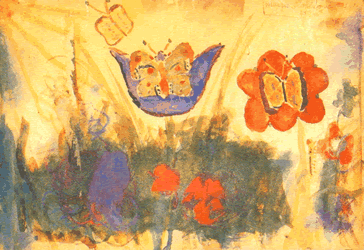
‘THE WORLD'S ABLOOM’ (2004)

‘THE WORLD'S ABLOOM’
PAINTED by TWO HUNDRED AND SIXTY FIVE STAFF and MEMBERS and PARTICIPANTS
of MAKOR JEWISH COMMUNITY LIBRARY CAULFIELD VICTORIA AUSTRALIA
2.2m x 1.4m





The idea of creating an artwork as a memorial to those who perished in the Holocaust has been a dream of mine for some years. I first stumbled across the poem “On a Sunny Evening” whilst reading the chapter titled ‘Hope’ in Elizabeth Kubler Ross’ On Death and Dying. In that chapter, Kubler Ross described coping mechanisms used by individuals in difficult situations; as she writes “the one thing that usually persists ... is hope”. “On a Sunny Evening”, written by an inmate at Terezin camp in 1944, beautifully illustrates this point:

"The sun has made a veil of gold
So lovely that my body aches.
Above, the heavens shriek with blue
Convinced I’ve smiled by some mistake.
The world’s abloom and seems to smile.
I want to fly but where, how high?
If, in barbed wire things can bloom
Why couldn’t I? I will not die!"
Whilst the name and fate of the poet is unknown, the sentiments captured in those words resonate across the decades. Although the poem was written over sixty years ago, its poignant message of hope has been my inspiration in designing “The World’s Abloom” project.
The essence of this project was the creation of a community artwork that illustrates the poem in a mix of visually beautiful images, whilst directly involving the members of the Makor Library, many of whom lived through, and only just survived, the Nazi period. Two hundred and sixty five artists contributed to the finished artwork, including child survivors - one of whom actually survived at Terezin for three years. It was my personal hope that participation in the creation of the artwork would be a source of joy and personal engagement, as well as reflection, for all the artists involved.
I was mindful the artwork should respect Jewish cultural traditions and, given the proposed hanging location of the work [in the children’s library], I wanted the spiritual aspects of the work to be uplifting and rich in meaning. Above all, I wanted the artwork to convey peace, tranquility, life and vitality - in essence a beautiful memorial to the victims of the Holocaust that a child today might gaze upon without fear. Artworks created by two Little girls from Terezin were the sad inspiration for the floral patterns that cover the bottom third of the painting. Friedl Dicker-Brandeis, a Bauhaus - trained art therapist and educator, encouraged Margit Koretzova, aged eleven, and Doris Weiserova, aged twelve, to paint and embroider before their deportation. Both Margit and Doris and their teacher perished in Auschwitz in the autumn of 1944.
The central combined tree of life and menorah, and the seven nourishing fruits of the Bible, are symbolic of life and death and resurrection. From the brutal strands of barbed wire that stand for the attempt to destroy the Jewish race and culture between 1939 and 1945, new Life has grown and flourished on shores far from Europe. The two hundred and sixty five names recorded on the edges of the artwork are further testament to hope and survival. The sun in the top left hand corner shines “a veil of gold” over a white dove, striving to fly high to spread peace and light to the whole world.



© 2016 McADAM AGED CARE ART RECREATION THERAPY (MAC.ART) All Rights Reserved.
